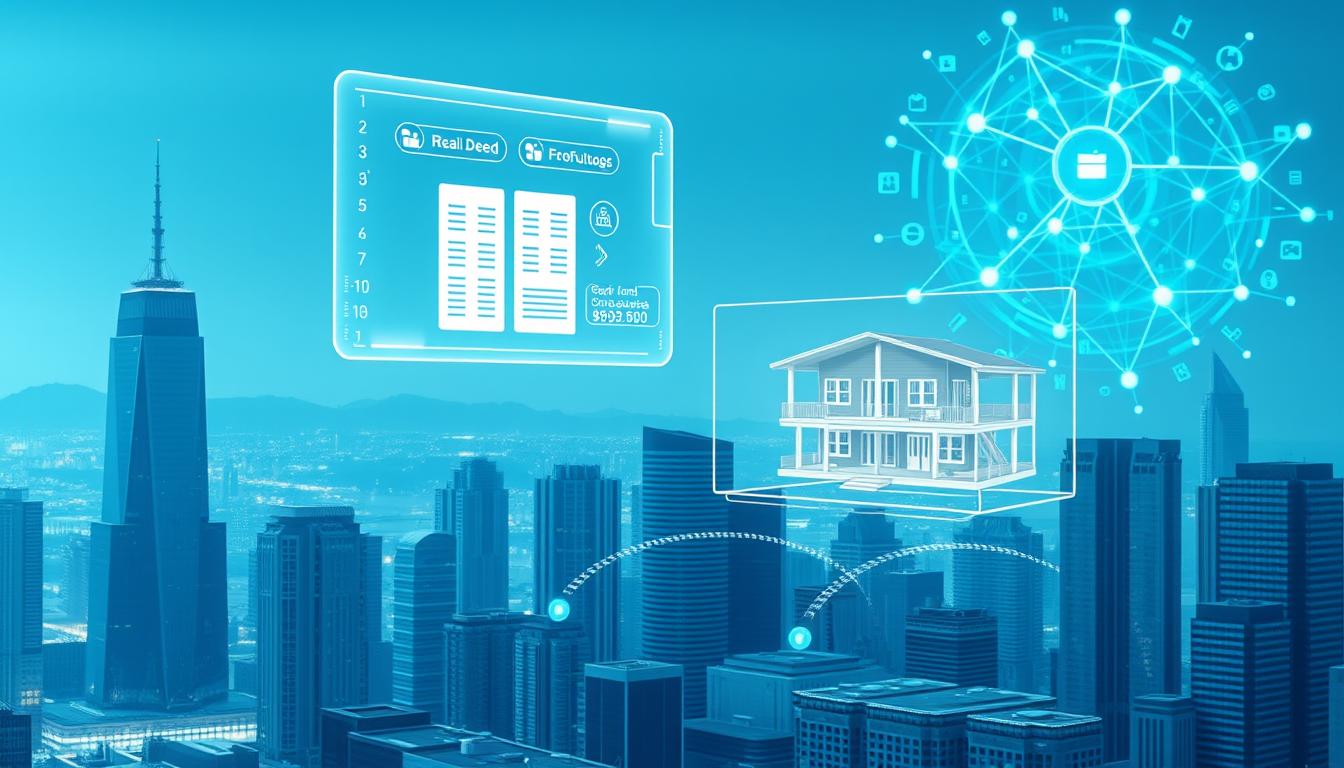Now Reading: Blockchain Technology for Real Estate: A Comprehensive Guide
- 01
Blockchain Technology for Real Estate: A Comprehensive Guide
Blockchain Technology for Real Estate: A Comprehensive Guide

Blockchain technology started in 2008 and is changing the $327 trillion real estate market. It uses digital ledgers to make transactions faster, cheaper, and more secure. Blockchain for real estate also makes sure ownership records are safe.
Smart contracts are at the heart of blockchain. They make agreements automatic and cut out middlemen like escrow services.
Old ways of doing real estate are slow and expensive. Blockchain brings in tokenization, letting properties be split into digital shares. This means more people can own a piece of property.
Platforms like crypto-backed real estate investments let buyers use cryptocurrencies for deals. But, there are still hurdles like unclear laws and resistance to change.
Key Takeaways
- Blockchain reduces transaction times by automating contract execution and verification.
- Tokenization allows smaller investors to access high-value real estate assets.
- Public ledgers improve transparency, lowering risks of fraud in property records.
- Adoption barriers include education gaps and inconsistent legal frameworks.
- Real estate professionals must adapt to blockchain to stay competitive in digital markets.
Understanding Blockchain for Real Estate: The Fundamentals
Blockchain technology is changing how we do property deals. It’s important to know its basics and how it works in real estate.
What Is Blockchain Technology?
Blockchain is a system where data is spread across many computers. It’s different from old databases because it keeps records safely and can’t be changed. For real estate, this means we can track property and deals openly, without needing middlemen.
Core Components of Blockchain Systems
Here are the main parts that make blockchain useful for real estate:
- Distributed networks: Data is on many computers, so there’s no single weak spot.
- Consensus mechanisms: Users agree on transactions, so we don’t need middlemen.
- Cryptographic security: Data is encrypted, keeping it safe from tampering.
- Blocks: New data is added to permanent “blocks” that link to the past, creating a solid history.
How Blockchain Differs from Traditional Systems
Old ways of doing real estate deals involve paper, slow searches, and extra costs for brokers or lawyers. Blockchain changes this with:
- Public ledgers instead of private databases
- Smart contracts that work automatically, not manual paperwork
- Instant updates, not slow record-keeping
These changes show how blockchain can save money, reduce mistakes, and increase trust in property deals.
The Evolution of Real Estate Transactions Before Blockchain
For centuries, buying and selling property relied on paper and face-to-face talks. Land deeds were written by hand and kept in county offices. They were passed on by notaries. By the 2000s, digital tools like e-signatures and online listings made some steps easier. But, big problems still existed, leading to the need for blockchain for real estate.
- Manual title searches took days, requiring visits to multiple offices
- Closing costs averaged 2-5% of sale prices due to intermediary fees
- Fragmented databases made verifying property histories error-prone
- Fraud cases involving forged documents cost U.S. buyers over $1 billion annually
Even with computers, deals were slow and hard to follow. Buyers and sellers had to trust each other, without a clear record of property history. This need for a reliable, open system led to decentralized real estate transactions. Blockchain technology now offers solutions to these old problems.
How Blockchain Addresses Traditional Real Estate Pain Points
Blockchain is changing the real estate world. It tackles high costs, slow processes, and red tape. This tech brings big benefits of blockchain for real estate by cutting costs, making documents clear, and speeding up deals.

Eliminating Intermediaries and Reducing Costs
Old real estate deals have many middlemen like title companies and lawyers. Blockchain removes these by allowing direct transfers. Sites like Propy and ShelterZoom let you buy properties without extra fees, saving up to 10% for both sides.
Smart contracts handle payments automatically when conditions are met. This means no more fees for middlemen.
Streamlining Documentation and Verification
Blockchain makes a single digital record for property info. It keeps track of who owns what, zoning, and inspections. Trials in Georgia and Sweden show it cuts fraud and speeds up checks by 90%.
No more endless paperwork. Everyone gets the same, accurate data in real time.
Enhancing Transaction Speed and Efficiency
Smart contracts on sites like RealT make deals faster and more reliable. In Miami, blockchain closings now take just 3 days, down from 30. It automates checks and escrow releases, making deals happen in a day.
This saves time and reduces errors. It’s a win for everyone involved.
Key Benefits of Implementing Blockchain in Property Transactions
Blockchain changes how we buy, sell, and manage properties. It solves old problems, bringing real benefits to everyone. Here’s how it adds value:
- Transparent Records: Every deal leaves a permanent digital mark. This means everyone sees the same information. Buyers can check property histories quickly, cutting down on scams.
- Cost Reduction: Less paperwork and fewer fees mean savings. For example, title insurance costs can fall by up to 30% with smart contracts.
- Global Accessibility: Digital tokens let investors from anywhere join in. This opens up markets to people worldwide.
- Rapid Settlements: Deals now close in days, not weeks. Smart contracts make payments happen automatically when conditions are met.
- Enhanced Security: Data is safe thanks to strong encryption. This lowers fraud as ownership is checked through a network.
- Asset Liquidity: Tokens let people invest in big properties without buying the whole thing. This frees up money for other investments.
These advantages have a big impact. Buyers trust the data, sellers sell faster, and lenders track assets in real time. For managers, smart contracts handle leases and payments. The benefits of blockchain for real estate make the whole system more efficient. Trust and speed lead to growth.
Tokenization: Transforming Real Estate into Digital Assets
Blockchain goes beyond secure transactions. It turns physical properties into digital assets, opening new investment doors. This makes owning and trading easier and more accessible.
What Is Real Estate Tokenization?
Tokenizing real estate means breaking down property rights into digital tokens on a blockchain. Each token stands for a share of ownership, all tracked clearly. For example, a $2 million apartment could be split into 2,000 tokens, making it easier to invest with just $1,000.
This method uses smart contracts to handle rights and payments automatically.
Fractional Ownership Models
- Lower investment barriers: People can buy parts of expensive properties they couldn’t afford before.
- Global access: Investors from around the world can invest in U.S. properties through tokens.
- Instant portfolio diversification: Spread investments across many properties without needing a lot of money.
Liquidity Benefits of Tokenized Properties
Tokenization makes real estate trading fast, unlike traditional markets. Properties can be traded 24/7 on digital platforms. Tokens can be sold quickly on sites like Securitize or Propy, cutting down sale times from months to minutes.
This quick trading attracts investors looking for fast returns.
Legal Frameworks for Tokenized Real Estate
States like Delaware and Wyoming are leading in clear laws. Delaware’s SB 60 allows tokenized real estate without needing state securities registration. But, following SEC rules is crucial, including anti-money laundering (AML) checks.
Legal teams must check each place’s rules on real estate tokenization to avoid trouble.
Smart Contracts: Automating Real Estate Agreements and Transactions
Smart contracts are self-executing agreements on blockchain networks. They work without middlemen, making sure terms are followed automatically when conditions are met. For blockchain applications in real estate, these contracts cut out manual steps. This reduces delays and mistakes.
In property deals, smart contracts manage escrow funds, rental payments, and ownership transfers. For instance, when a buyer pays through a platform like Propy, the contract sends funds to the seller right away. This happens after title verification is done. It makes decentralized real estate transactions happen 24/7, without needing third-party approval.
Key uses include:
- Automated rent collection and late fee triggers
- Dividend payouts for fractional property owners
- Conditional clauses for property inspections
- Automated lease renewals or terminations
Even though they’re efficient, legal acceptance varies by place. Developers must write contracts that follow state property laws. It’s also important to have clear code reviews and ways to solve disputes. As more platforms use these tools, they promise to speed up and secure real estate work.
Blockchain Solutions for Property Management and Leasing
Blockchain is changing how we manage properties by making routine tasks easier and more transparent. Landlords and property managers use blockchain solutions for property management to save money and better serve tenants. These systems make sure everything is accurate and clear at every step.
Systems for collecting rent automatically cut down on delays. Smart contracts handle payments on time, even adding late fees if needed. They keep records safe. Sites like Propy and RealT already have these features, making things easier for everyone.
Maintenance gets better with blockchain too. It keeps a permanent record of every repair and payment. For example, Blockstack lets everyone see how work is going, and only pays when it’s done right.
- Rent payments processed in real time via smart contracts
- Maintenance histories accessible to all stakeholders
- Tenant backgrounds verified through encrypted data
Checking tenant backgrounds gets better with blockchain. Landlords can see rental histories without sharing personal info. Companies like Everledger make it possible to share data safely. This cuts down on fraud and makes sure credit checks are accurate.
Now, over 40% of U.S. property firms are trying out blockchain. Reports from 2023 show these new tools are making things better for everyone involved.
Land Registry and Title Management on the Blockchain
Blockchain technology is changing land registries and title systems in real estate. It stores ownership data on decentralized ledgers, making things more efficient and accurate. This change helps solve long-standing problems in managing property records through three main ways:
Immutable Records for Property Ownership
Every time a property is transferred, it’s recorded on the blockchain. This creates a permanent record that can’t be changed by anyone. It stops fake documents and mistakes that happen in old systems.
Now, both public and private groups can check property titles in real time. They don’t need to look through old files anymore.
Reducing Title Fraud and Disputes
Blockchain makes it hard to fake property ownership by making all changes clear. Smart contracts can spot problems, and special codes keep records safe from tampering. Companies like First American and Old Republic are testing this to cut down on fraud.
Current Implementation Efforts Across the US
- Cook County, Illinois: Launched a blockchain pilot in 2023, cutting title searches from weeks to hours
- Wyoming: Became first state to legally recognize blockchain records in 2022, attracting tech firms like Propy to test platforms
- Arizona: Partnered with Bitprop to automate deed transfers using smart contracts during real estate closings
- Vermont: Deployed blockchain ledgers to track easements and zoning changes since 2021
Early users say they’ve cut costs by 30-50% in title searches. But, making systems work together across states is still a big challenge.
Real-World Case Studies: Successful Blockchain Real Estate Projects
Blockchain in real estate is now a reality. Here are four real examples of projects that have shown real success:

- Manhattan Office Tokenization: A $50M New York office building was turned into tokens. This allowed $500 investments, attracting over 500 investors. They raised $12M in just six months. This made high-value assets more accessible to small investors.
- County Title Registry Overhaul: A U.S. county cut title search times from 10 days to 12 hours with blockchain. Fraud attempts plummeted by 95%. This shows blockchain’s power in keeping records safe.
- Smart Contract Rental Platform: A startup used smart contracts to automate leases. This cut disputes by 80%. Now, lease signings take minutes, not weeks.
- Tokenized REIT Success: A REIT with tokenized shares saw investor numbers triple. The minimum investment dropped from $50k to $1k, with 15% annual returns. This shows how tokenization can make investing more democratic.
These projects highlight blockchain’s benefits. It cuts costs, opens up access, and builds trust. The data shows real returns, from 90% faster processes to 300% more investors. Blockchain is not just a trend. It’s changing real estate operations across the country.
Regulatory Landscape for Blockchain Technology in US Real Estate
Understanding the rules for blockchain technology in real estate is crucial. Federal and state laws set the stage. The SEC, FINRA, and FinCEN have strict rules for tokenizing real estate assets. The IRS also views digital assets as taxable.
At the federal level, the SEC watches over token sales under securities laws. FinCEN has rules for money transmission. But, states like Wyoming are ahead, allowing smart contracts and digital records.
Arizona and Nevada have laws that recognize digital signatures and tokenized property rights. Yet, other states are slow to adapt to these new ideas.
- Wyoming: Enacted statutes validating blockchain records and crypto transactions.
- Arizona: Requires acceptance of blockchain signatures on real estate documents.
- Nevada: Streamlined processes for fractional ownership via tokenization.
There are big challenges ahead. These include making blockchain transfers work with old recording laws. Also, proving digital signatures are valid and meeting KYC/AML standards for token sales. Brokers need licenses for digital assets, and this varies by state.
Proposals in Congress could bring changes. They aim to standardize taxes and security for blockchain in real estate. This could lead to federal reforms.
Professionals need to keep up with changing laws. They should use states like Wyoming as examples. Knowing about new laws helps them stay compliant as blockchain technology in real estate grows.
Security Considerations for Blockchain-Based Property Transactions
Keeping blockchain for real estate systems safe is crucial. Even with decentralized networks, threats like key theft or code flaws can harm transactions.
Protecting Digital Keys and Wallets
Private keys are vital for decentralized real estate transactions. Here are some key steps:
- Store keys in hardware wallets for offline safety
- Need multi-signature approval for transfers
- Use biometric or password-protected recovery systems
Data Privacy and Compliance
GDPR and CCPA rules apply to blockchain data. Here’s how to stay compliant:
- Use permissioned networks to control access
- Encrypt personal details before blockchain entry
- Automate audit trails to track data handling
Smart Contract Vulnerability Assessment
Code flaws can lead to financial risks. Here’s how to stay safe:
- Get third-party audits before deployment
- Use formal verification tools to check logic
- Have insurance for smart contract failures
By taking proactive steps, we can trust blockchain for secure property dealings.
Implementation Guide: How to Integrate Blockchain into Your Real Estate Business
Adding blockchain to real estate needs a clear plan. This guide shows how to use blockchain applications in real estate well.

Assess Organizational Readiness
Check your IT setup and see where blockchain can help. Look at property listings, lease deals, or payment systems. Make sure everyone is on board and set aside money for development and training.
Select the Right Blockchain Platform
Look at options like Ethereum for smart contracts or Hyperledger Fabric for private networks. Consider how well it scales, its security, and if it fits with your systems. Public blockchains are good for open systems, while private ones are better for managing properties.
Build a Technical Team
Find developers who know blockchain or work with companies like Propy or ShelterZoom. Teach them about smart contracts, digital wallets, and following the law. You might need to hire outside help at first.
Plan Your Rollout
- Begin with a small project, like making digital leases with blockchain solutions for property management.
- Test it in a small setting.
- Grow it slowly after fixing any problems.
- Make sure it fits with your yearly goals.
Start thinking about legal rules early, especially in the U.S. Make sure your team and clients know how to use the new tech.
Overcoming Adoption Challenges in the Real Estate Industry
Adopting blockchain for real estate is tough due to resistance from old players and tech complexity. Many don’t see its value, and others worry about changing their systems. To overcome these, we need specific plans.
Teaching people is key. Workshops and small projects help them understand blockchain technology in real estate. Companies like Propy and ShelterZoom show it’s possible to slowly add new tech without big problems. Working with tech companies and regulators can build trust and set standards.
- Network effect challenges: Start with niche applications—such as title registries—to attract early adopters.
- User-friendly tools: Platforms like RealT offer simplified interfaces, masking technical layers from end-users.
- Legacy system integration: APIs bridge blockchain with existing software, enabling hybrid setups without full overhauls.
- Cost management: Focus on high-ROI areas like fraud reduction first, proving value before scaling.
Cost worries fade when we see the long-term savings. For instance, smart contracts can cut escrow delays, saving money. By focusing on practical steps and teamwork, we can make the shift smoothly.
Comparing Public and Private Blockchain Solutions for Real Estate
When it comes to blockchain applications in real estate, the choice between public and private blockchains is key. Each type has its own strengths and weaknesses that affect property management strategies.
Ethereum-Based Applications
Public blockchains like Ethereum offer open, decentralized platforms for blockchain solutions for property management. They allow global participation and support complex smart contracts. Yet, high gas fees and slow transaction speeds can be challenges.
Platforms like Propy and RealT use Ethereum to tokenize assets. But, scalability is still a big issue. For more on cryptocurrency’s role, see how tokenization drives innovation in property markets.
Hyperledger Solutions for Enterprise
Private blockchains like Hyperledger Fabric focus on control and privacy, perfect for confidential transactions. They allow companies to set their own rules and governance. This makes them popular with big investors.
However, their closed nature limits working with outside systems and public networks. IBM’s blockchain services use Hyperledger for supply chain and title management, showing its value for big companies.
Selecting the Right Blockchain Type
- Public chains: Best for public-facing platforms requiring broad participation.
- Private chains: Optimal for regulated industries needing strict data control.
Business goals like speed, privacy, and following rules help decide between public and private blockchains. Startups might choose Ethereum for innovation, while big companies might pick Hyperledger for rules. Think about how much you need to do and how you want to work with others before making a choice.
Future Trends: How Blockchain Will Continue to Transform Property Markets
Blockchain’s impact on real estate is just starting. New ideas like real estate tokenization and tokenizing real estate assets will change the game. We’re seeing new trends emerge.

- IoT Sensors: Smart devices will watch over properties, sending updates to the blockchain.
- AI & Predictive Analytics: AI will look at tokenized assets to predict market changes and improve investments.
- AR Integration: Augmented reality tours will use blockchain data for a smooth virtual experience.
- DAO-Driven Ownership: Decentralized groups might manage shared properties through smart contracts.
- CBDCs: Digital currencies from central banks could make buying and selling tokenized assets easier.
Getting clear rules is crucial. Experts say we’ll see stricter rules by 2026 as tokenized real estate grows. Companies like Propy and Harbor are already testing these systems. They’ve seen a 40% cut in settlement times in their tests.
As the tech gets better, we might see more people using it by 2027-2030. Businesses need to keep up with tech and work with platforms that use real estate tokenization. Being ready for these changes can put companies ahead in a more open and easy-to-use real estate world.
Taking the First Steps Toward a Blockchain-Powered Real Estate Future
Real estate pros can start by joining groups like the Real Estate Blockchain Alliance. They can also attend events like the Real Asset Tokenization Summit. Platforms like Propy let you test blockchain title transfers.
Investors can try decentralized real estate with fractional ownership on RealT. Developers can start with pilot projects using Ethereum smart contracts. They aim to cut transaction times by 20%.
Consultants like Spherity or guides from BIRES offer helpful advice. Starting small helps manage risks and shows blockchain’s benefits. Even small steps, like digitizing records on ShelterZoom, help move forward.
Learning is crucial. Online courses from Coursera or whitepapers from Harbor explain blockchain basics. Conferences like Consensus 2024 and sandbox environments like R3’s Corda are great for learning and testing.
This journey takes time. But every step, from smart contract trials to tokenization, brings us closer to a transparent and efficient real estate future. Adopting these tools now prepares you to lead in an innovative market.
FAQ
What is the role of blockchain technology in real estate?
Blockchain changes real estate by making transactions secure and transparent. It also cuts down costs. This makes buying and selling properties easier and cheaper.
How does blockchain address inefficiencies in real estate transactions?
Blockchain removes middlemen and speeds up paperwork. It makes transactions fast and cheap. This solves old problems like high costs and slow closings.
What are the benefits of implementing blockchain in property management?
Blockchain helps with rent collection and tracking maintenance. It also keeps tenant data private. This makes managing properties more efficient and secure.
Can blockchain help reduce title fraud in real estate?
Yes, blockchain makes property ownership records unchangeable. This greatly lowers the chance of title fraud. It ensures clear and verifiable ownership.
What is real estate tokenization, and why is it important?
Real estate tokenization turns properties into digital tokens. This allows for shared ownership and easier investment. It makes real estate more accessible to more people.
How do smart contracts work in real estate transactions?
Smart contracts are self-running agreements. They enforce terms automatically when conditions are met. This makes processes like payment and rental agreements more efficient.
What regulatory considerations are there for blockchain in real estate?
There are federal and state laws for blockchain in real estate. The SEC has guidelines, and states have their own rules. These affect how you can use blockchain for transactions and property transfers.
How does blockchain improve transparency in real estate dealings?
Blockchain makes records public and secure. This lets everyone check information easily. It builds trust among all parties involved.
What are the current real-world examples of blockchain applications in real estate?
There are many examples of blockchain in real estate. Tokenized properties let small investors in. Blockchain title registries speed up processing. Smart contract platforms automate rental agreements.
What challenges must be overcome for blockchain adoption in real estate?
There are several hurdles to blockchain adoption. Resistance from old-timers, tech complexity, and fitting into old systems are big ones. Also, unclear laws need to be sorted out.















